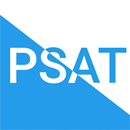PSAT
The PSAT/NMSQT (Preliminary SAT/National Merit Scholarship Qualifying Test) is a standardized test that acts as a practice exam for the SAT as well as an opportunity for students to qualify for National Merit Scholarship Programmes.The PSAT was founded in 1971. It was developed by the College Board, which also developed the SAT (Scholastic Assessment Test).
The PSAT costs $18, however this varies by school. Some schools may pay the entire or a portion of this fee, allowing students to take the test for free, while others may charge an additional fee to cover the expense of test proctors.
If you are unable to pay the test fee, you may be qualified for a PSAT fee waiver, since low-income 11th graders are eligible. Consult your counselor to see if you are eligible for a waiver. Fee waiver requests from schools, not students, are granted by the College Board.
Certainly! Here is a list of advantages of the PSAT exam for students:
1. Practice for the SAT: The PSAT serves as a valuable practice test for the SAT, allowing students to familiarize themselves with the format, question types, and pacing of the exam.
2. Assess Strengths and Weaknesses: By taking the PSAT, students can assess their strengths and weaknesses in different subject areas, helping them identify areas that require further improvement and focus.
3. Readiness Indicator: The PSAT provides an indication of a student's readiness for the SAT, helping them gauge their current skill level and determine if they need to undertake additional preparation before the actual SAT exam.
4. National Merit Scholarship Qualification: High-scoring PSAT test takers have the opportunity to qualify for the National Merit Scholarship Program, which can provide financial assistance for college education.
5. Scholarship Opportunities: In addition to the National Merit Scholarship, some colleges and universities use PSAT scores to identify potential scholarship recipients. Performing well on the PSAT can increase a student's chances of receiving financial aid.
6. College and Career Planning: The PSAT offers an opportunity for students to indicate their interest in receiving information from colleges and universities. This can help students explore various educational opportunities and receive valuable information about programs, scholarships, and admissions.
7. Test-Taking Experience: Taking the PSAT provides students with a firsthand experience of a standardized test environment, helping to alleviate test anxiety and build confidence for future exams, including the SAT.
8. Access to Test Resources: The College Board provides comprehensive resources, including practice materials, sample questions, and study guides, specifically designed for PSAT preparation. These resources can be utilized to enhance test-taking skills and improve overall performance.
9. Performance Feedback: The PSAT provides students with a detailed score report, including section-wise scores and percentiles. This feedback helps students understand their strengths and weaknesses and provides a benchmark for further improvement.
10. College Admission Test Practice: Since the PSAT is similar in content and structure to the SAT, preparing for the PSAT indirectly helps students prepare for the SAT, which is a widely accepted college admission test.
11. Time Management Skills: The timed nature of the PSAT helps students develop essential time management skills, which are crucial for success on standardized tests and in academic settings.
12. Early Identification of Potential Advanced Placement (AP) Courses: PSAT scores can be used to identify students who may excel in specific subject areas, providing an early opportunity to consider advanced placement courses or academic enrichment programs.
13. Personalized Study Plan: The PSAT can guide students in creating a personalized study plan based on their performance and areas that need improvement, enabling them to allocate their study time effectively.
14. Academic Growth: Preparing for the PSAT encourages students to engage in focused academic preparation, enhancing their knowledge, critical thinking skills, and problem-solving abilities.
15. Competitive Advantage: A strong PSAT performance can give students a competitive edge when applying to colleges and universities, showcasing their academic abilities and commitment to excellence.
Remember, while the PSAT offers numerous advantages, it is important to approach it as a valuable learning opportunity and a stepping stone towards achieving academic goals.
PSAT Highlights
A) This is a paper-based standardized test,which serves as a practice test for the PSAT and offers several benefits to them.
B) PSAT is conducted only once in a year in the United States. The specific date can vary from year to year, but it is usually scheduled in october.
C) Students' knowledge is assessed using the Critical Reading section, Mathematics section, and Writing section.
D) The SAT questionnaire is supposed to take 2 hours and 45 minutes to complete.
E) The scoring system uses a 1520 scale. The possible PSAT scores range from 320 to 1520, with increments of 10 points. The scale for math and evidence-based reading and writing (EBRW) is 160-760. EBRW combines the reading and writing parts.) These two section scores accurately reflect your scaled or equated results.
Syllabus for PSAT
|
Reading and Writing |
Assessing comprehension skills and ability to analyze passages from various genres |
|
Writing and Language |
Evaluating grammar, usage, and editing skills; identifying errors and improving sentence clarity |
|
Math- No Calculator |
Testing problem-solving skills without a calculator; multiple choice, and grid-in questions |
|
Math- Calculator |
Assessing problem-solving skills with a calculator; Multiple choice and grid-in questions |
|
Optional Essay (PSAT) (NMSQT Essay) |
Analyzing the provided passages and writing a well-structured essay |
(1) Evidence-based Reading and Writing (EBRW)
A) Reading: This section measures your ability to understand and analyze passages from various genres, such as literature, historical documents, social sciences and natural sciences. They test your comprehension, reasoning and vocabulary skills.
B) Writing and Language: In this section, you’ll be tested on your grammar, usage, and editing skills. You’ll need to identify and correct errors and sentence structure, punctuation, grammar, and word choice. Additionally, you’ll be asked to improve sentences and paragraphs, organization and clarity.
(2) Maths
A) Heart of algebra: This topic focuses on solving linear equations and inequalities,system of linear equations, and interpretation of linear functions.
A) Problem solving and Data Analyses: This section covers topics such as ratios, percentages, proportions, statistics, data interpretation, and graph analysis.
B) Passport to Advanced math: It includes more complex topics like quadratic equations, exponential and logarithmic functions, radicals, and rational expressions.
C) Additional Topics in math: This section covers Geometry, trigonometry and complex numbers.
D) The Math section includes both Multiple-choice questions and Grid-in questions.
Update Information & Earn INR 200





 SAT (Scholastic Aptitude Test...)
SAT (Scholastic Aptitude Test...)